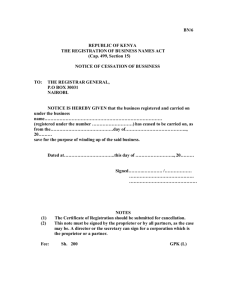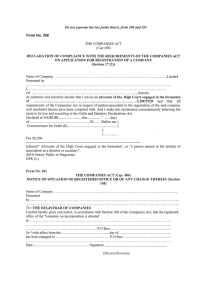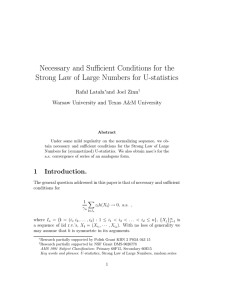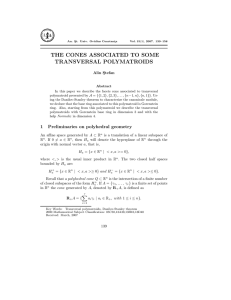GLOBAL BEHAVIOR OF A HIGHER-ORDER RATIONAL DIFFERENCE EQUATION
advertisement
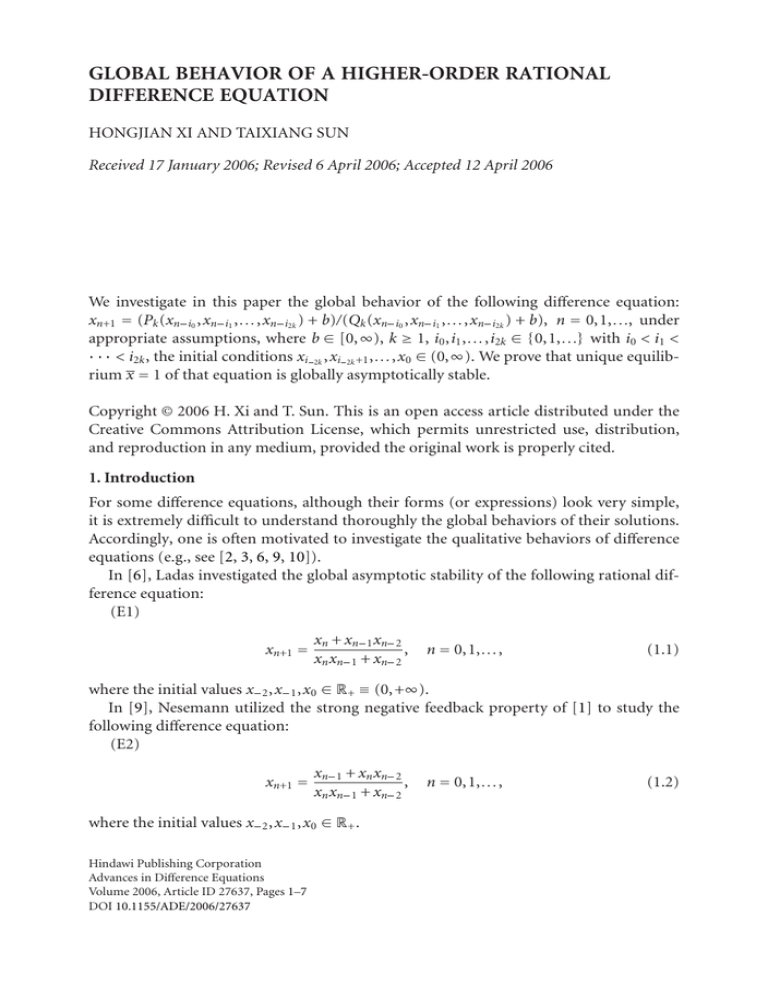
GLOBAL BEHAVIOR OF A HIGHER-ORDER RATIONAL DIFFERENCE EQUATION HONGJIAN XI AND TAIXIANG SUN Received 17 January 2006; Revised 6 April 2006; Accepted 12 April 2006 We investigate in this paper the global behavior of the following difference equation: xn+1 = (Pk (xn i0 ,xn i1 ,...,xn i2k ) + b)/(Qk (xn i0 ,xn i1 ,...,xn i2k ) + b), n = 0,1,..., under appropriate assumptions, where b [0, ), k 1, i0 ,i1 ,...,i2k 0,1,... with i0 < i1 < < i2k , the initial conditions xi 2k ,xi 2k +1 ,...,x0 (0, ). We prove that unique equilibrium x = 1 of that equation is globally asymptotically stable. Copyright © 2006 H. Xi and T. Sun. This is an open access article distributed under the Creative Commons Attribution License, which permits unrestricted use, distribution, and reproduction in any medium, provided the original work is properly cited. 1. Introduction For some difference equations, although their forms (or expressions) look very simple, it is extremely difficult to understand thoroughly the global behaviors of their solutions. Accordingly, one is often motivated to investigate the qualitative behaviors of difference equations (e.g., see [2, 3, 6, 9, 10]). In [6], Ladas investigated the global asymptotic stability of the following rational difference equation: (E1) xn+1 = xn + xn 1 xn xn xn 1 + xn 2 , 2 n = 0,1,..., (1.1) where the initial values x 2 ,x 1 ,x0 R+ (0,+). In [9], Nesemann utilized the strong negative feedback property of [1] to study the following difference equation: (E2) xn+1 = xn 1 + xn xn xn xn 1 + xn where the initial values x 2 ,x 1 ,x0 Hindawi Publishing Corporation Advances in Difference Equations Volume 2006, Article ID 27637, Pages 1–7 DOI 10.1155/ADE/2006/27637 R+ . 2 2 , n = 0,1,..., (1.2) 2 Global behavior of a difference equation In [10], Papaschinopoulos and Schinas investigated the global asymptotic stability of the following nonlinear difference equation: (E3) xn+1 = iZk j 1, j xn i + xn j xn j+1 + 1 iZk xn i n = 0,1,..., , (1.3) where k 1,2,3,..., j, j 1 Zk 0,1,...,k, and the initial values x k ,x k+1 ,..., x 0 R+ . Recently, Li [7, 8] studied the global asymptotic stability of the following two nonlinear difference equations: (E4) xn+1 = xn 1 xn 2 xn 3 + xn 1 + xn 2 + xn 3 + a , xn 1 xn 2 + xn 1 xn 3 + xn 2 xn 3 + 1 + a n = 0,1,... (1.4) (E5) xn+1 = xn xn 1 xn 3 + xn + xn 1 + xn 3 + a , xn xn 1 + xn xn 3 + xn 1 xn 3 + 1 + a n = 0,1,..., (1.5) where a [0,+) and the initial values x 3 ,x 2 ,x 1 ,x0 R+ . Let k 1 and i0 ,i1 ,...,i2k 0,1,... with i0 < i1 < < i2k . Let P0 (xn Q0 (xn i0 ) = 1, for any 1 j k, let P j xn i0 ,...,xn i2 j = xn i2 j x n i2 j + xn Q j xn i0 ,...,xn i2 j = xn i2 j + xn i2 j x n i2 j + xn i2 j 1 + 1 Pj i2 j xn 1 Qj 1 1 + xn + 1 Qj i2 j 1 1 Pj xn 1 xn 1 xn i0 ,...,xn i2 j i0 ) i0 ,...,xn i2 j i0 and 2 i0 ,...,xn i2 j i0 ,...,xn i2 j = xn , 2 (1.6) 2 2 . In this paper, we consider the following difference equation: Pk xn i ,xn i1 ,...,xn xn+1 = 0 Qk xn i0 ,xn i1 ,...,xn i2k i2k +b , +b n = 0,1,..., (1.7) where b [0, ) and the initial conditions x i2k ,x i2k +1 ,...,x0 (0, ). It is easy to see that the positive equilibrium x of (1.7) satisfies x= Pk (x,x,...,x) + b Qk (x,x,...,x) + b 2 x + 1 Pk = 2 1 (x,x,...,x) + 2xQk 1 (x,x,...,x) + b x + 1 Qk 1 (x,x,...,x) + 2xPk 1 (x,x,...,x) + b (1.8) . H. Xi and T. Sun 3 Thus, we have (x 1) x2 + x Qk 1 (x,x,...,x) + (x + 1)Pk 1 (x,x,...,x) + b = 0, (1.9) from which one can see that (1.7) has the unique positive equilibrium x = 1. Remark 1.1. Let k = 1, then (1.7) is (1.4) when (i0 ,i1 ,i2 ) = (1,2,3) and is (1.5) when (i0 ,i1 ,i2 ) = (0,1,3). 2. Properties of positive solutions of (1.7) In this section, we will study properties of positive solutions of (1.7). Since Pk xn i0 ,xn i1 ,...,xn i2k = xn = = xn = xn i2k i2k i0 1 xn Qk xn i ,xn i ,...,xn i 1 Pk 1 xn i ,... ,xn i 0 1 2k 1 0 1 xn i 1 xn i 1 1 xn i 1 xn i 1 , 2k 1 2 1 2k xn i2k i1 2 Qk 1 xn 1 P0 xn i0 i0 ,...,xn i2k Q0 xn i0 2 2k (2.1) it follows from (1.7) that for any n 0, xn+1 1 = xn 1 xn i1 1 xn i2k 1 . Qk xn i0 ,xn i1 ,...,xn i2k + b i0 (2.2) Definition 2.1. Let xn n= i2k be a solution of (1.7) and an n= i2k a sequence with an 1,0,1 for every n i2k . an n= i2k is called itinerary of xn n= i2k if an = 1 when xn < 1, an = 0 when xn = 1, and an = 1 when xn > 1. From (2.2), we get the following. be a solution of (1.7) whose itinerary is a Proposition 2.2. Let x n n= i2k , then for any n 0. i1 i2k Proposition 2.3. Let xn n= i2k be a solution of (1.7), then it follows that xn = 1 for any n 1 ij2k=0 (x j 1) = 0. be a , then it follows from Proposition 2.2 that Proof. Let itinerary of x an+1 = an i 0 an an n n= i2k n n= i2k n n= i2k xn = 1 for any n 1 an = 0 for any n 1 i2k 2k = 0 ij=0 (x j 1) = 0. Proposition 2.4. If gcd(is + 1,i2k + 1) = 1 for some s 0,1,...,2k 1, then a positive solution xn n= i of (1.7) is eventually equal to 1 x p = 1 for some p i2k . j =0 a j 2k Proof. “If ” part is obvious. “Only if ” part. If x p = 1 for some p i2k , then a p = 0, where an n= i2k is itinerary . By Proposition 2.2, we have a = a = 0 for any j 0. Since of xn j(i2k +1)+p j(is +1)+p n= i2k gcd(is + 1,i2k + 1) = 1, we see that for any t 0,1,...,i2k , there exist jt 1,2,...,i2k + 1 4 Global behavior of a difference equation and mt 0,1,...,is + 1 such that jt is + 1 = mt i2k + 1 + t. (2.3) Together with Proposition 2.2, it follows that a(is +1)(i2k +1)+t+p = 0. (2.4) Again by Proposition 2.2, we have an = 0 for any n (is + 1)(i2k + 1) + p, which implies xn = 1 for any n (is + 1)(i2k + 1) + p. Example 2.5. Consider the equation xn+1 = x n i0 x n i1 x n 3 + x n i0 + x n i1 + x n 3 + b , x n i0 x n i1 + x n i0 x n 3 + x n i1 x n 3 + 1 + b n = 0,1,..., (2.5) where b [0,+), 0 i0 < i1 < 3, and the initial values x 3 ,x 2 ,x 1 ,x0 R+ . Let xn n= 3 be a solution of (2.5) whose itinerary is an n= 3 , then the following hold. (1) If (i0 ,i1 ) (0,1),(1,2) and xn n= 3 is not eventually equal to 1, then an n= 3 is a periodic sequence of period 7. (2) If (i0 ,i1 ) = (0,2) and xn n= 3 is not eventually equal to 1, then an n= 3 is a periodic sequence of period 6. (3) xn = 1 for any n 1 0j = 3 (x j 1) = 0. (4) xn n= 3 is eventually equal to 1 x p = 1 for some p 3. Proof. (1) If (i0 ,i1 ) = (0,1), then from Proposition 2.2, it follows that for any n 0, an+4 = an+3 an+2 an = an+2 an+1 an 1 an+2 an = an+1 an an 1 = a n an 1 an 3 an an (2.6) 1 = an 3 . If (i0 ,i1 ) = (1,2), then in a similar fashion, it is true that an+4 = an 3 for any n 0. (2) If (i0 ,i1 ) = (0,2), then from Proposition 2.2, it follows that for any n 0, an+3 = an+2 an an 1 = an+1 an 1 an 2 an an = an+1 an an 2 = a n an 2 an 3 an an 2 1 (2.7) = an 3 . (3) It follows from Proposition 2.3. (4) It follows from Proposition 2.4 since either gcd(i0 + 1,4) = 1 or gcd(i1 + 1,4) = 1. 3. Global asymptotic stability of (1.7) In this section, we will study global asymptotic stability of (1.7). To do this, we need the following lemmas. H. Xi and T. Sun 5 Lemma 3.1. Let (y0 , y1 ,..., yi2k ) i2k , then i +1 R+2k (1,1,...,1) and M = max y j ,1/ y j 0 j Pk yi , yi ,..., yi2k 1 < M. < 0 1 M Qk yi0 , yi1 ,..., yi2k (3.1) Proof. Since (y0 , y1 ,..., yi2k ) Ri+2k+1 (1,1,...,1) and M = max y j ,1/ y j 0 j i2k , we have M > 1 and either M a > 1/M or M > a 1/M for any a y j ,1/ y j 0 j i2k . It is easy to verify that P 1 y i0 , y i1 , y i2 = y i1 y i2 + 1 y i0 + y i1 + y i2 < y i1 y i2 + 1 M + y i1 + y i2 y i0 M = Q1 yi0 , yi1 , yi2 M, P 1 y i0 , y i1 , y i2 M = y i1 y i2 + 1 y i0 + y i1 + y i2 M (3.2) > y i1 y i2 + 1 + y i1 + y i2 y i0 = Q1 yi0 , yi1 , yi2 . From that we have P2 yi0 , yi1 , yi2 , yi3 , yi4 = yi3 yi4 + 1 P1 yi0 , yi1 , yi2 + yi3 + yi4 Q1 yi0 , yi1 , yi2 < yi3 yi4 + 1 Q1 yi0 , yi1 , yi2 M + yi3 + yi4 P1 yi0 , yi1 , yi2 M = Q2 yi0 , yi1 , yi2 , yi3 , yi4 M, P2 yi0 , yi1 , yi2 , yi3 , yi4 M = yi3 yi4 + 1 P1 yi0 , yi1 , yi2 + yi3 + yi4 Q1 yi0 , yi1 , yi2 M > yi3 yi4 + 1 Q1 yi0 , yi1 , yi2 + yi3 + yi4 P1 yi0 , yi1 , yi2 = Q2 yi0 , yi1 , yi2 , yi3 , yi4 . (3.3) By induction, we have that for any 1 j k, P j yi0 , yi1 ,..., yi2 j < Q j yi0 , yi1 ,..., yi2 j M, P j yi0 , yi1 ,..., yi2 j M > Q j yi0 , yi1 ,..., yi2 j . (3.4) Thus Pk yi , yi ,..., yi2k 1 < M. < 0 1 M Qk yi0 , yi1 ,..., yi2k (3.5) 6 Global behavior of a difference equation Let n be a positive integer and let ρ denote the part-metric on Rn+ (see [11]) which is defined by x yi ρ(x, y) = log min i , 1 i n y i xi for x = x1 ,...,xn , y = y1 ,..., yn Rn+ . (3.6) It was shown by Thompson [11] that (Rn+ ,ρ) is a complete metric space. In [4], Krause and Nussbaum proved that the distances indicated by the part-metric and by the Euclidean norm are equivalent on Rn+ . Lemma 3.2 [5]. Let T : Rn Rn be a continuous mapping with unique fixed point x Rn . + + + Suppose that there exists some l 1 such that for the part-metric ρ, ρ T l x,x < ρ x,x x = x . (3.7) Then x is globally asymptotically stable. Theorem 3.3. The unique equilibrium x = 1 of (1.7) is globally asymptotically stable. Proof. Let xn n= i2k be a solution of (1.7) with initial conditions x i2k ,x i2k +1 ,...,x0 i +1 R 2k such that x is not eventually equal to 1 since otherwise there is nothing to n n= i2k + show. Denoted by T : Ri+2k +1 Ri+2k +1 the mapping T xn i2k ,xn i2k +1 ,...,xn Pk xn i0 ,xn i1 ,...,xn = xn i2k +1 ,xn i2k +2 ,...,xn , Qk xn i0 ,xn i1 ,...,xn i2k i2k +b . +b (3.8) Then solution xn n= i2k of (1.7) is represented by the first component of the solution yn n=0 of the system yn+1 = T yn with initial condition y0 = (x i2k ,x i2k +1 ,...,x0 ). It follows from Lemma 3.1 that for all n 0, the following inequalities hold: min xn i , 1 xn i 0 i i2k < xn+1 < max xn i , 1 xn i 0 i i2k . (3.9) Inductively, we obtain that for all n 0 and all 1 j i2k + 1, min xn i , 1 xn i 0 i i2k < xn+ j < max xn i , 1 xn i 0 i i2k , (3.10) from which it follows that min xn i , 1 xn i 0 i i2k < min xn+i , 1 xn+i 1 i i2k + 1 . (3.11) H. Xi and T. Sun 7 Thus, for x = (1,1,...,1) and the part-metric ρ of Ri+2k +1 , we have ρ T i2k +1 yn ,x = log min xn+i , < log min xn i , = ρ yn ,x 1 xn+i 1 xn i 1 i i2k + 1 0 i i2k (3.12) for all n 0. It follows from Lemma 3.2 that the positive equilibrium x = 1 of (1.7) is globally asymptotically stable. Acknowledgments Project supported by NNSF of China (10461001, 10361001) and NSF of Guangxi (0640205). References [1] A. M. Amleh, N. Kruse, and G. Ladas, On a class of difference equations with strong negative feedback, Journal of Difference Equations and Applications 5 (1999), no.6, 497–515. [2] C. Çinar, On the positive solutions of the difference equation xn+1 = αxn 1 (1 + bxn xn 1 ), Applied Mathematics and Computation 156 (2004), no. 2, 587–590. [3] H. M. El-Owaidy, A. M. Ahmed, and M. S. Mousa, On the recursive sequences xn+1 = αxn 1 (β xn ), Applied Mathematics and Computation 145 (2003), no. 2-3, 747–753. [4] U. Krause and R. D. Nussbaum, A limit set trichotomy for self-mappings of normal cones in Banach spaces, Nonlinear Analysis 20 (1993), no. 7, 855–870. [5] N. Kruse and T. Nesemann, Global asymptotic stability in some discrete dynamical systems, Journal of Mathematical Analysis and Applications 235 (1999), no. 1, 151–158. [6] G. Ladas, Open problems and conjectures, Journal of Difference Equations and Applications 4 (1998), no. 1, 497–499. [7] X. Li, Global behavior for a fourth-order rational difference equation, Journal of Mathematical Analysis and Applications 312 (2005), no. 2, 555–563. , Qualitative properties for a fourth-order rational difference equation, Journal of Mathe[8] matical Analysis and Applications 311 (2005), no. 1, 103–111. [9] T. Nesemann, Positive nonlinear difference equations: some results and applications, Nonlinear Analysis 47 (2001), no. 7, 4707–4717. [10] G. Papaschinopoulos and C. J. Schinas, Global asymptotic stability and oscillation of a family of difference equations, Journal of Mathematical Analysis and Applications 294 (2004), no. 2, 614– 620. [11] A. C. Thompson, On certain contraction mappings in a partially ordered vector space, Proceedings of the American Mathematical Society 14 (1963), no. 3, 438–443. Hongjian Xi: Department of Mathematics, Guangxi College of Finance and Economics, Nanning, Guangxi 530004, China E-mail address: xhongjian@263.com Taixiang Sun: Department of Mathematics, College of Mathematics and Information Science, Guangxi University, Nanning, Guangxi 530004, China E-mail address: stx1963@163.com
